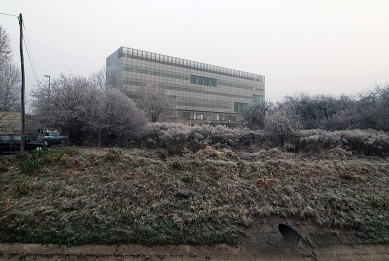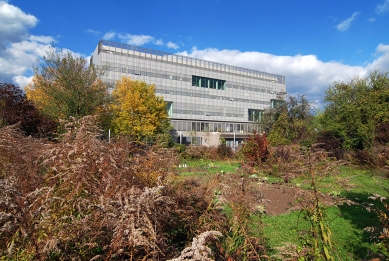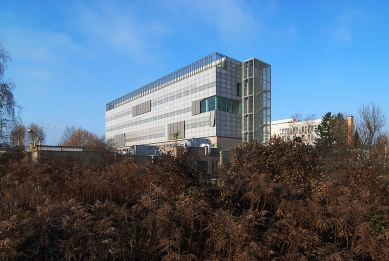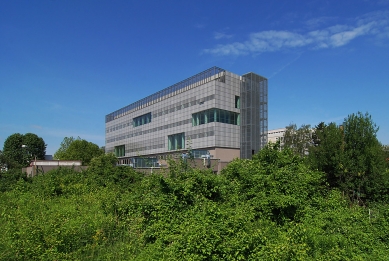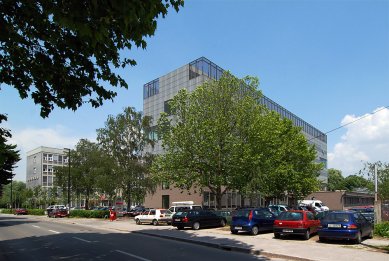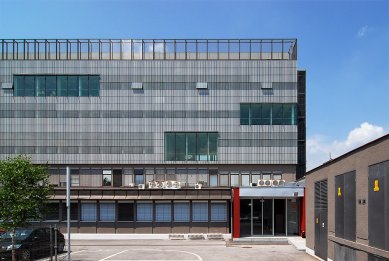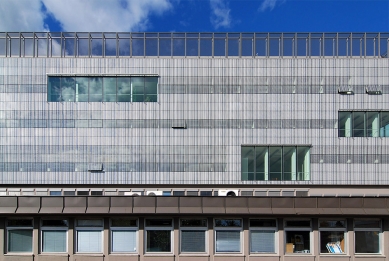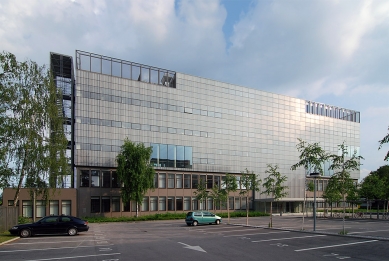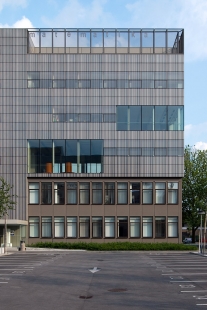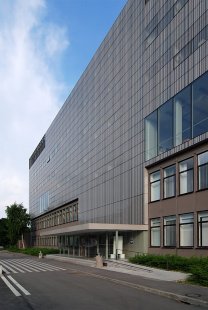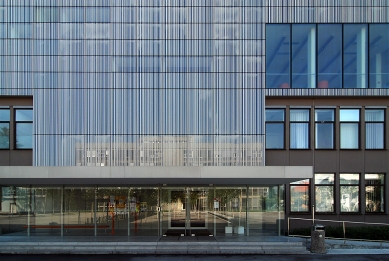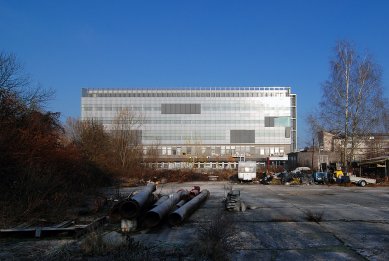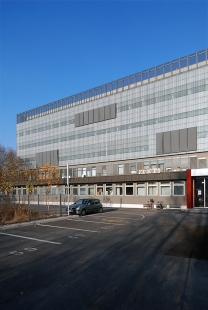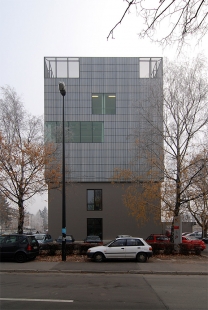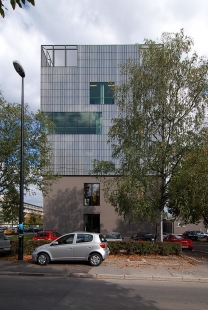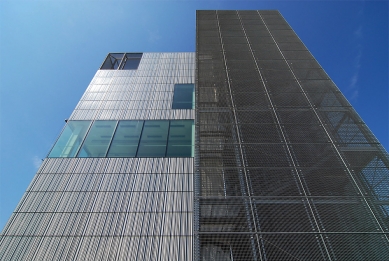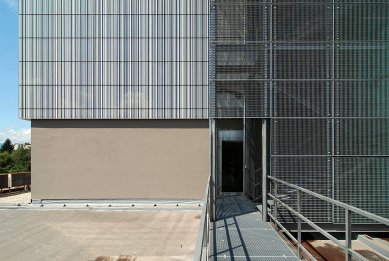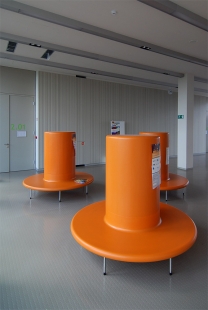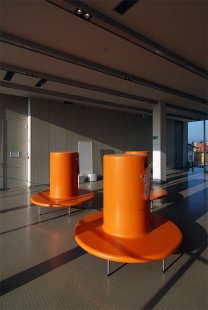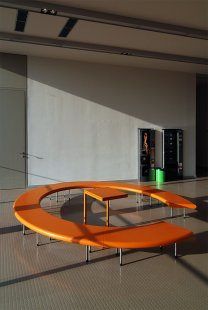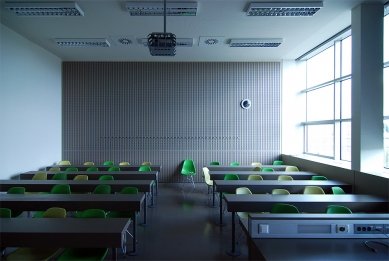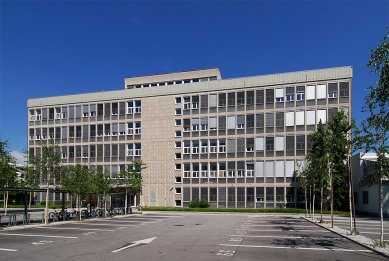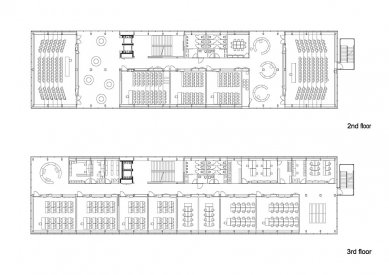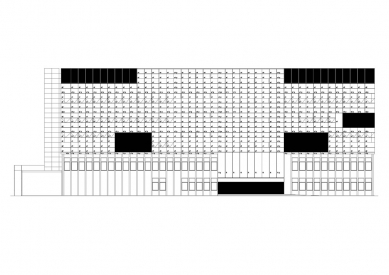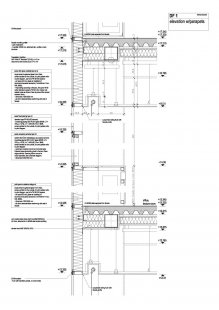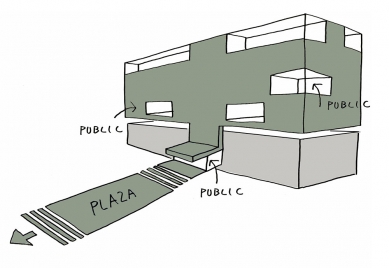
Faculty of Mathematics

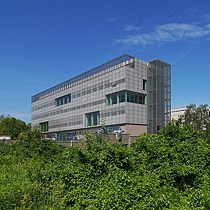 |
The new building literally grows out of the old structure, but despite its dominant role it allows the old structure its independence and dignity.
Being an edifice without the ‘ground floor’, the new building tries to develop the idea of public spaces of the school as series of transparent ‘rooms’, carved out of the building mass, hovering above the city. From anonymous entrance marked by the lowered ‘curtain’ of printed glass, the illuminated staircase leads to the second floor, which becomes the new ‘ground floor’ of the building. It contains lecture halls and two large communal areas of the school. All other programmes of the school follow on higher floors, culminating in two small urban gardens on the top floor of the building.
A formally and structurally simple architecture is precisely formulated, whether one looks at the programmatic organization or at tactile treatment of surfaces. Elegant glass skin, screen printed with different densities of the same pattern, speaks about the programmatic structure hiding behind. Three levels of print transparency correspond to three three different programmes - from very dense print for computer rooms to very diffuse print for standard classrooms.
Random repetitive prints appear as if they are forming an independent, almost plastic overall surface of the edifice. The building is at the same time stereo metric and monodimensional, a parallelepiped and a skin, a firm monolith and a dynamic structure.
Only the public and communal spaces of the school have transparent, floor-size glass panels without prints, thus establishing a delicate conversation of the interior with the city beyond.
The relation with the adjacent building, the faculty of Physics is established through an open ‘field’, containing parking and public square.
bevk perović arhitekti
At first sight the whole story seems illogical, but it is true that the new Faculty of Mathematic Building is built on top of a privately owned computer company building, currently under reconstruction by another architect. The plot along Jadranska Street in Ljubljana was reserved for two faculty buildings, but in 1968 they built only the Faculty of Physics, while of the mathematical building only the foundations were made before the money ran out. Instead they built a building that hosted the central Slovenian computer system. In the times of political and economic changes the centre was privatised and became a private computer company. When the money for the new building for the Faculty of Mathematics finally came, it was logical that the new building would be built on their own land, not to mention the foundations. This decision brought some problems with it. First, they had to solve the construction that had to protrude through two lover floors, second problem is that the faculty has no hall on the ground floor, as would be normal, as the ground floor belongs to the other company. There is only enough space for the stairs and elevators and visitors have to reach the third floor where the faculty really starts. In this floor there are two large halls in front of two large lecture rooms. In the fourth floor there are normal lecture rooms along the central corridor, the public spaces – two halls are situated in the end corners of the building. In the fifth floor there are cabinets for professors with small reception rooms in the middle of the two parallel corridors, where professors can meet with their students. The teacher’s staff room with a cafeteria act as public space on this floor. The last floor is devoted to offices and there is still enough space for three terraces. The money was, as always in such cases, limited and for the interior the architects used simple and clear solutions. The only part where architects could show their ambition is the façade itself. As the terraces are covered with steel frames the whole volume of the building is a clear rectangular box where only the sun protection screens an South façade and fire escape stairs on the back façade are added. The rest is glass façade, treated in three ways. The parts in front of public spaces are covered with clear glass, the rest is glass printed with vertical stripes. Some glass is in front of windows the rest covers the façade. In this way the unique volume of the building is treated in different ways, making different effects during the day and night. The printed glass also diminishes its transparency and takes away some of the reflex so typical for glass facades. The lower part of the building is a story of its own, and the new façade covers it only in the entrance part thus marking it. The connection with the old Faculty of Physics building is marked with a small park with trees leading across the parking space from which is divided by a long bench and a roof of bicycle stand. Both elements accent the connection between buildings who are, among other things, similar in shape and dimension.
Andrej Hrausky
2 comments
add comment
Subject
Author
Date
estetika normalizované architektury 70. a 80. let
ja
02.04.07 04:36
Na vlastní oči
iNKa_1104
26.02.09 12:22
show all comments


